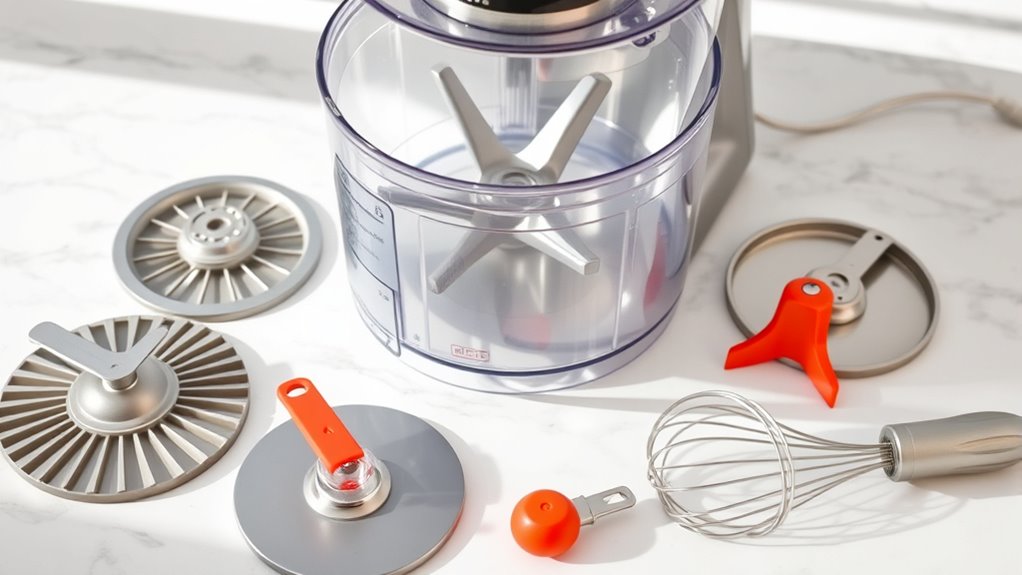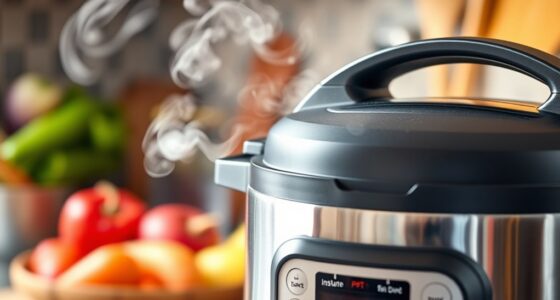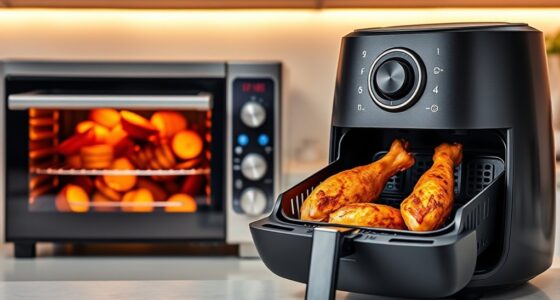A guide to food processor attachments and their uses helps you understand how to use various blades, discs, and accessories effectively. You’ll learn about multi-purpose blades for chopping and mixing, slicing and shredding discs for vegetables, and specialized tools like dicing kits or spiralizers for creative prep. Proper assembly, safety tips, and maintenance guarantee efficient performance, while techniques for use and storage help extend your attachments’ lifespan. Keep exploring, and you’ll discover how to maximize your food processor’s versatility even further.
Key Takeaways
- Different blades and discs serve specific functions like chopping, slicing, shredding, and kneading dough.
- Proper assembly, safety procedures, and regular maintenance ensure optimal performance and longevity of attachments.
- Using short pulses and uniform ingredients enhances control and consistency during processing.
- Additional accessories such as julienne blades and spiralizers expand food prep options.
- Correct storage and cleaning practices prevent damage and keep attachments safe and ready for use.
Understanding the Different Types of Food Processor Blades and Discs
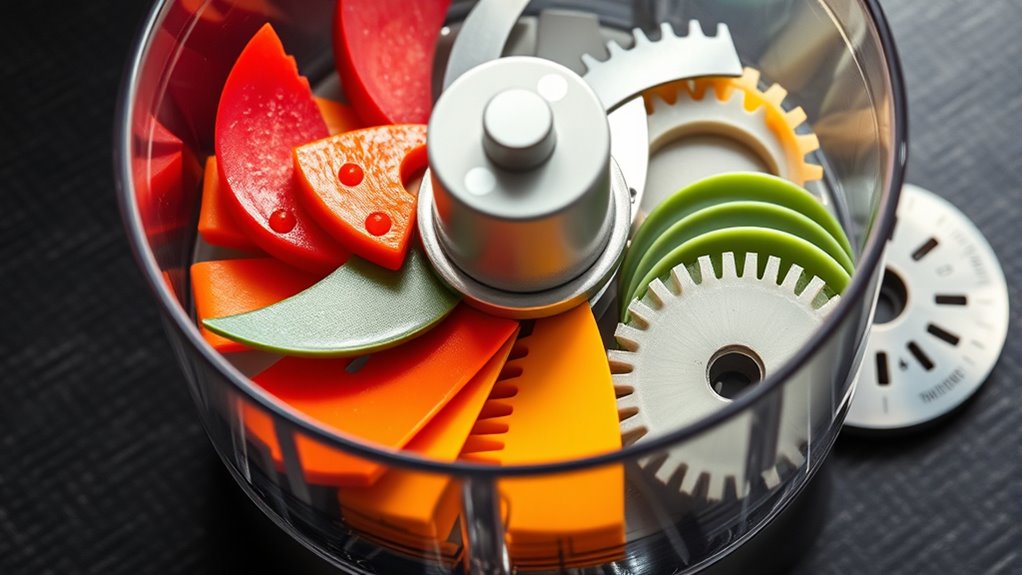
Understanding the different types of food processor blades and discs is essential for achieving the best results in your food prep. Food processor blades, such as the multi-purpose blade and dough blade, serve specific functions. The multi-purpose blade, often called the S-blade, handles chopping, pureeing, and mixing with ease. Discs come in various styles, typically reversible, with slicing discs offering thin or thick cuts and shredding discs producing fine or coarse textures. Slicing discs are perfect for vegetables, while shredding discs excel at cheese or carrots. The dough blade, usually made of plastic with dull edges, kneads bread or pizza dough efficiently. Choosing the right blade or disc guarantees your food prep is faster, cleaner, and produces the desired texture every time. Properly selecting food processor attachments can also extend the appliance’s versatility and lifespan. Additionally, understanding how to change gears on a gravel bike can be crucial for maintaining smooth operation and prolonging your equipment’s lifespan, especially when dealing with different terrains. Being aware of the different attachment types helps you utilize your food processor more effectively and safely. Knowing that blades and discs are made from durable materials can help prevent accidents and ensure longevity. Incorporating mindfulness techniques during food prep can enhance focus and reduce kitchen stress, making cooking a more enjoyable experience.
Exploring Common Attachments and Accessories for Versatile Food Preparation
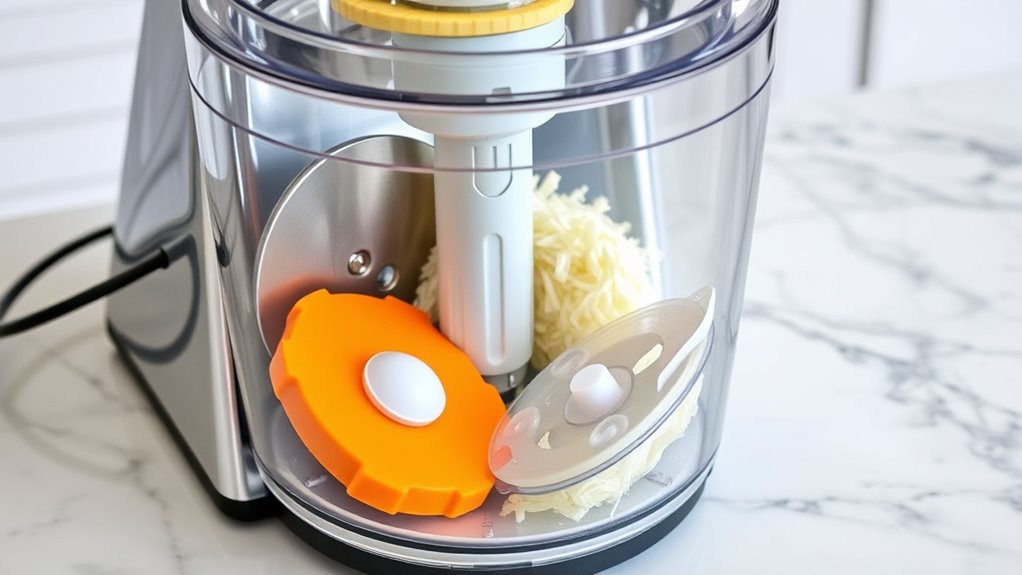
Food processor attachments and accessories considerably expand the range of tasks you can accomplish with your appliance. Slicing discs and shredding discs are essential for quickly preparing vegetables, cheese, or meats, with reversible options offering different thicknesses or coarseness. Dicing kits and julienne blades help you achieve uniform cubes or strips, perfect for salads and stir-fries. Additional blades and accessories, like spiralizers, enhance your food prep versatility. Many models include in-bowl storage compartments, keeping blades and discs organized and accessible. External accessories, such as adjustable slicing guides and dicing grids, provide even more precision. By exploring these common attachments and accessories, you’ll *unlock* your food processor’s full potential and streamline your cooking routines. Also, understanding the design of your food processor can help you select compatible attachments that fit seamlessly. Moreover, choosing the right attachments based on your specific needs can significantly improve your efficiency in the kitchen. Incorporating space-saving storage solutions for your accessories can further enhance your organization and ease of use. Additionally, being aware of safety features such as blade guards can help prevent accidents during operation. Being mindful of spiritual energy can also create a more harmonious environment in your kitchen, promoting calm and focus while preparing meals.
Properly Assembling and Securing Attachments for Safe and Efficient Use
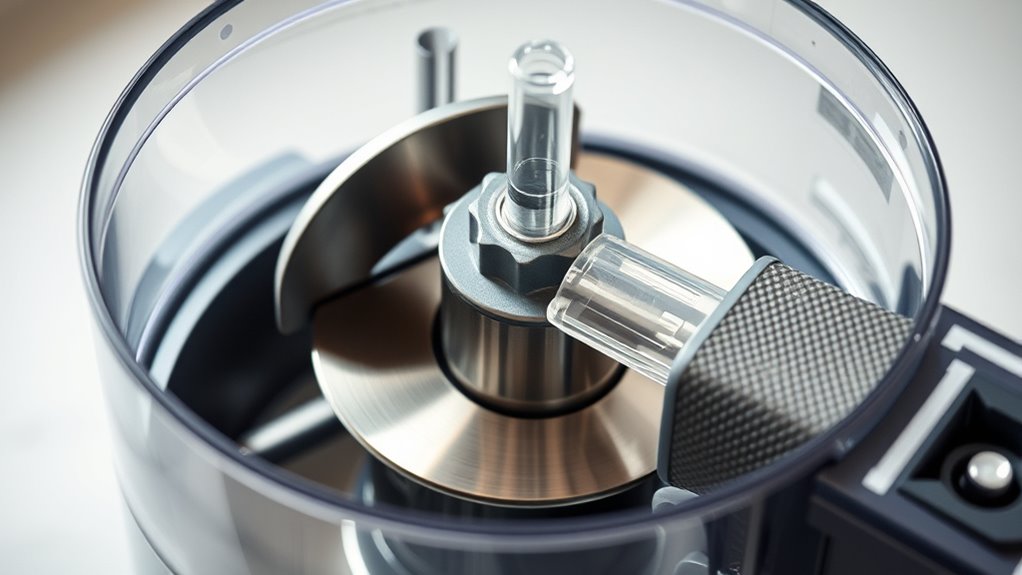
To guarantee safe and efficient operation, always double-check that the work bowl is securely locked into the base before attaching any blades or discs. Properly attaching these components involves aligning them correctly on the drive shaft or adapter, ensuring they are fully seated and locked in place. Confirm that the blades or discs are secure to prevent slipping or misalignment during use. Before powering on, verify that the lid and work bowl are properly locked and aligned, with all safety mechanisms engaged. When installing the feed tube or food pusher, make sure they fit snugly into the lid or bowl for stability and safety. Regularly inspect attachments for security and debris to maintain ideal performance and prevent accidents during operation. Additionally, understanding attachment compatibility helps ensure that only appropriate accessories are used, reducing the risk of damage or injury. Being familiar with the juicery process can also help in selecting attachments that are suitable for handling different fruit textures and pulp levels. Moreover, following the manufacturer’s instructions for attachment installation can further enhance safety and functionality. Recognizing proper attachment maintenance practices can extend the lifespan of your food processor and ensure consistent performance. Furthermore, being aware of cookie categories and their functions can help manage safety and privacy preferences effectively.
Techniques for Using Blades and Discs to Achieve Perfect Results
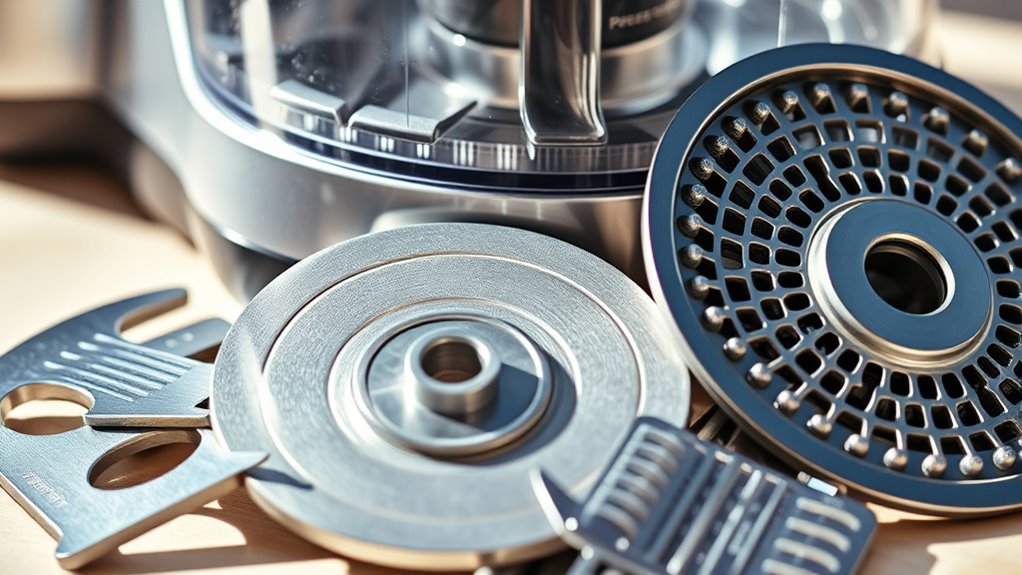
To get the best results, make sure you attach blades and discs securely before starting. Use short pulses for better control, and feed ingredients evenly to guarantee uniform processing. Adjust your speed and time based on what’s being prepared for consistent, professional outcomes. Recognizing narcissistic traits can help in understanding how individuals might manipulate or react during interactions.
Proper Attachment Techniques
Before attaching blades or discs, always unplug the food processor to prevent accidental activation. To guarantee a secure attachment, insert the blades or discs firmly onto the drive shaft or adapter, aligning them correctly. For slicing discs, position the raised blade face-up; for shredding discs, face-down. Use the feed tube and food pusher to guide ingredients safely into the blades, avoiding direct contact with sharp edges. When installing, make sure the attachment is fully seated and locked in place before powering on. Proper attachment technique prevents slipping or improper operation, which can affect your results. Additionally, always verify that the headphone connection is secure to ensure optimal audio performance during use. After use, carefully remove blades or discs by gently lifting or pulling them off the drive shaft, using a towel or glove for safety. Ensuring proper attachment security helps maintain the efficiency of your food processor. Correct attachment ensures top performance and safety, and paying attention to heat pump noise levels can contribute to a more comfortable environment.
Optimal Food Preparation Tips
Using the right blades and discs for each task is essential for achieving perfect results with your food processor. Select the appropriate kitchen attachments, like a shredding disc for vegetables or a dough blade for kneading, to optimize performance. Always use the pulse setting in short bursts to control ingredient size and avoid over-processing. Insert ingredients gradually through the feed tube to promote even processing and reduce strain on the motor. Keep ingredients cold when shredding or slicing to ensure cleaner cuts and prevent sticking or mushiness. Regularly clean and dry blades and discs after use to maintain sharpness and prevent rust, which guarantees consistent, high-quality results. Ensure the attachment compatibility is suitable for your food processor model before use. Make sure the drive adapter is securely connected to work bowls for safe and efficient operation. Additionally, understanding the different attachment types can help you select the best tool for each specific task, enhancing your overall food preparation experience. Proper blade maintenance is crucial for preserving sharpness and longevity, ensuring reliable performance over time. Incorporating regular sharpening routines can further improve cutting performance and extend the lifespan of your blades.
Controlling Processing Consistency
Controlling processing consistency involves applying techniques that give you precise results every time. Using the pulse function in short bursts helps regulate texture and prevents over-processing, ensuring uniform size and better control over the final product. Feeding ingredients that are cut into uniform pieces promotes even chopping, slicing, or shredding. Pre-chilling vegetables and cheeses can further improve processing consistency by reducing stickiness. Adjusting speed settings—low for gentle mixing and high for pureeing—lets you fine-tune the texture. Regularly checking the texture during processing prevents overdoing it and guarantees the desired outcome. These techniques give you better control over the final result, allowing you to achieve consistent, professional-quality dishes with your food processor.
Cleaning and Storing Food Processor Attachments to Maintain Performance

To keep your food processor attachments performing their best, proper cleaning and storage are essential. You should wash all parts promptly and use appropriate tools to reach tricky spots, ensuring thorough hygiene. When storing, dry everything completely and keep blades and discs organized to prevent damage and rust.
Proper Cleaning Techniques
Proper cleaning and storing of food processor attachments are essential for maintaining their performance and longevity. Always disassemble all removable parts, including blades, discs, and the work bowl, before cleaning. Wash blades and discs separately by hand with warm, soapy water to prevent dulling and corrosion, then dry thoroughly. Use a soft brush or sponge to clean hard-to-reach areas like the feed tube and inside the work bowl, avoiding abrasive scrubbers that could damage surfaces. For dishwasher-safe attachments, place them on the top rack and avoid high heat or aggressive cycles. Regularly inspect blades and discs for wear or damage, and store them in a designated, dry container to prevent damage and ensure quick access for future use.
Safe Storage Practices
After thoroughly cleaning your food processor attachments, the next step is storing them correctly to keep them in top condition. Proper storage helps preserve blades, discs, and accessories, guaranteeing they stay sharp and safe to use. Always dry all parts completely before storing to prevent mold, rust, and tarnishing. Store attachments in a designated, dry container or in the in-bowl compartment to avoid damage and accidental injuries. Use protective covers or blade guards on sharp blades to enhance safety and maintain their edge. Regularly inspect stored attachments for signs of wear or damage; replace dull or chipped blades to ensure peak performance. Keeping everything clean, dry, and properly stored not only extends the lifespan of your food processor attachments but also guarantees safe and efficient operation every time.
Upgrading and Customizing Your Food Processor With Additional Tools
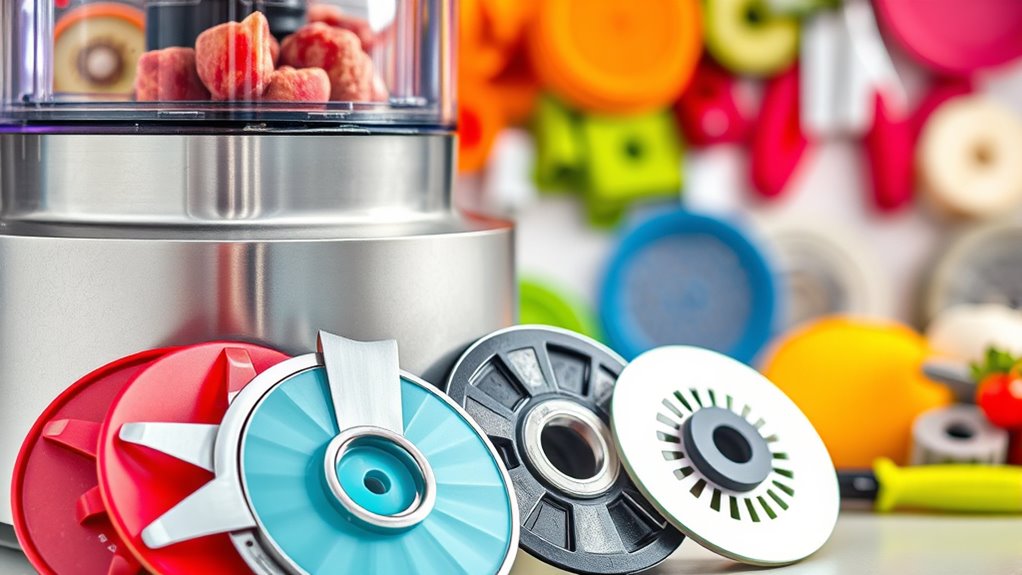
Enhancing your food processor with additional attachments can considerably expand its capabilities, making it more versatile for various culinary tasks. With the right accessories, you can customize your machine to handle everything from dicing to julienne slicing. Adding extra blades, such as fine grating discs or julienne blades, allows for more precise food prep. Many models support optional attachments like spiralizers, citrus juicers, or external adjustable slicers, which improve versatility and control. These accessories often fit specific models and can be purchased separately, enabling you to tailor your food processor to your needs. Properly integrating and maintaining these tools ensures maximum performance and extends your device’s lifespan. Upgrading your food processor with these tools makes it a more efficient, multifunctional kitchen helper.
Frequently Asked Questions
Which Food Processor Blade Does What?
You wonder which food processor blade does what. The multipurpose S-blade is perfect for chopping, pureeing, and making nut butters. Reversible slicing and shredding discs give you uniform slices or shreds, with adjustable thickness. The dough blade kneads bread and pastry dough without tearing. Slicing discs, placed on top with the feed tube, produce even slices of vegetables or fruits. Each blade suits specific tasks, boosting your food prep versatility.
Can I Cream Butter and Sugar in a Food Processor?
Yes, you can cream butter and sugar in a food processor. Just make sure the butter is softened to room temperature, and use a plastic paddle or dough blade. Process on low speed with short bursts to avoid over-mixing. It’s faster than doing it by hand, usually taking about 30 seconds to a minute. Keep a close eye to prevent the mixture from becoming greasy or overheated.
Which Food Processor Blade to Use for Bread Crumbs?
Think of your food processor as a culinary wizard, wielding its S-blade like a magic wand. To craft perfect bread crumbs, you want the pulse setting, not the shredding or slicing discs. Use small, even bread pieces and pulse gently to avoid turning it into flour. Clean the blade afterward to keep your magic sharp. With the right blade and technique, you’ll create flawless crumbs every time.
What Blade to Grind Meat in a Food Processor?
To grind meat in your food processor, use the metal S-shaped blade or a dedicated meat grinding blade if you have one. Make sure to cut the meat into small chunks, about 1-2 inches, and chill it in the freezer for 15-30 minutes beforehand. Process in pulses, checking the texture regularly to avoid overprocessing or overheating. Always clean the blades thoroughly afterward to maintain food safety.
Conclusion
Now that you know how to choose, assemble, and use your food processor attachments, you’re ready to open endless culinary possibilities. But the real secret lies in what you’ll discover next—tips and tricks that can elevate your skills even further. Are you prepared to take your food prep to the next level? Stay tuned, because the most exciting part is just around the corner—and you won’t want to miss it.
